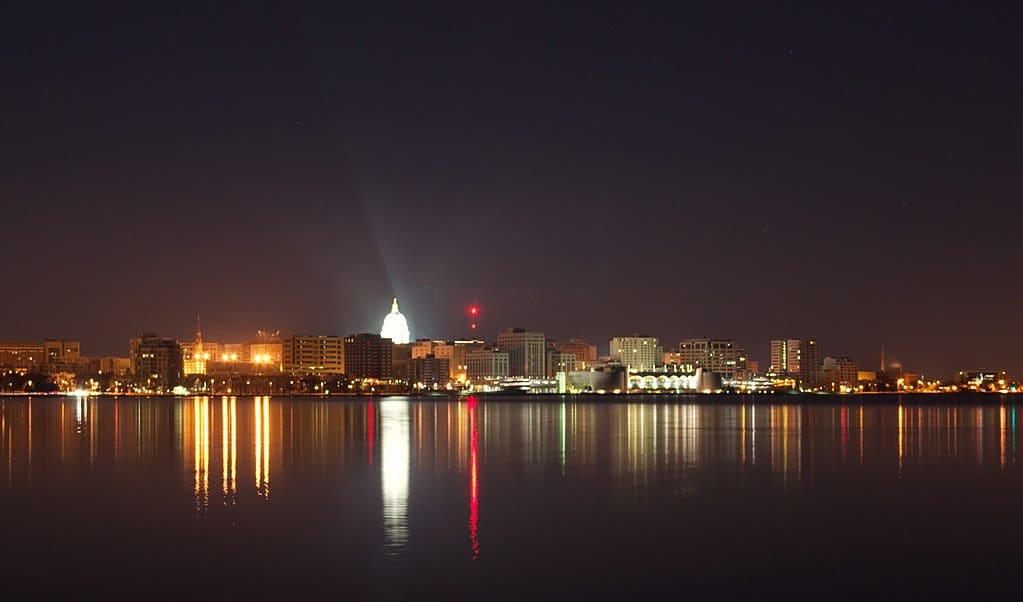Wisconsin has “an ambitious but possible path” to zero carbon from all sectors by 2050, as shown by an economy-wide carbon modeling study that was “unprecedented” for the state, said Andrew Kell, policy analyst at Renew Wisconsin, a study sponsor.
Wisconsin would add 31 GW of solar, 21 GW of wind and 7 GW of battery storage under the study’s net-zero economy-wide scenario, while electrifying transportation, heating and industry. The state would also add transmission and flexible demand, and improve energy efficiency.
The economy-wide study builds on work by the Wisconsin Governor’s Task Force on Climate Change, and a clean energy plan prepared by the state government, said Chelsea Chandler, a program director with Clean Wisconsin, a study sponsor. The study showed that “the transition to a clean energy future is absolutely feasible for our state,” she said.
Economy-wide decarbonization by 2050 would cost about the same as both a baseline “business as usual” scenario and a 100% clean electricity scenario, the modeling showed. When counting the health benefits of reduced fine particulate pollution from ending fossil fuel combustion, the net-zero economy-wide scenario would yield net savings compared to business as usual. The economy-wide scenario would also reduce carbon emissions 40% by 2030, compared to the 2005 level.
The consultancy Evolved Energy Research conducted the modeling, using both the open source EnergyPATHWAYS model of all energy-using technologies in the economy, and its proprietary economy-wide RIO optimization model. The consultancy GridLab, a study sponsor, published the study, plus a summary and a companion report on economic and jobs impacts.
The companion study projected that pursuing the net-zero economy-wide path would create an additional 68,000 jobs in manufacturing, construction, electricity and other services. “Wisconsin’s labor market is well prepared to meet these new labor needs,” GridLab said, as the state awards 5,000 engineering degrees and certificates annually.
The summary report recommends 30 policy measures that the state legislature or the state utilities regulator could pursue, to help achieve net-zero emissions economy-wide.
Distributed solar
Distributed solar installations were assumed to total 2.5 GW by 2050, or 8% of the total solar installed. That amount was not selected by the model, said Clean Wisconsin attorney Brett Korte, because several factors that would most influence distributed solar adoption were not included in the modeling. Those factors include rate design and incentive programs, job promotion programs, and customer preference that goes beyond a cost/benefit analysis, he said.
Rooftop solar deployment was instead estimated based on a rooftop solar potential report prepared by the consultancy Cadmus, specifically for Wisconsin, which projected market adoption through 2034.
Other resources
The net-zero economy-wide scenario also called for 18 GW of added transmission capacity linking Wisconsin to three neighboring states, and demand flexibility achieved with 2 GW of hydrogen electrolyzers and 3 GW of dual-fuel electric boilers that could switch between pipeline gas and electricity. Gas-fired generating units by 2050 would be fueled by methane from anaerobic digestion of biomass, and would run only 5% of the time.
The report acknowledges that the changes in the economy required to follow the net-zero economy-wide scenario would be “significant,” including “demand-side transformation” to achieve a switch to electric vehicles and heating, associated expansion of the electricity distribution infrastructure, transmission expansion to access out-of-state resources, and rapid growth of renewables.
The study examined several other scenarios to achieve 100% clean energy if, for example, consumer purchases of electric vehicles and heat pumps lagged the central scenario’s expectations, or it was not possible to add transmission.
The Evolved Energy Research study is titled “Achieving 100% Clean Energy in Wisconsin.” Renew Wisconsin represents both the renewables industry and individual members, and is the state affiliate of the national solar trade group SEIA. Clean Wisconsin is a citizen’s group that works to protect Wisconsin’s clean water, clean air and natural heritage.
This content is protected by copyright and may not be reused. If you want to cooperate with us and would like to reuse some of our content, please contact: editors@pv-magazine.com.








By submitting this form you agree to pv magazine using your data for the purposes of publishing your comment.
Your personal data will only be disclosed or otherwise transmitted to third parties for the purposes of spam filtering or if this is necessary for technical maintenance of the website. Any other transfer to third parties will not take place unless this is justified on the basis of applicable data protection regulations or if pv magazine is legally obliged to do so.
You may revoke this consent at any time with effect for the future, in which case your personal data will be deleted immediately. Otherwise, your data will be deleted if pv magazine has processed your request or the purpose of data storage is fulfilled.
Further information on data privacy can be found in our Data Protection Policy.